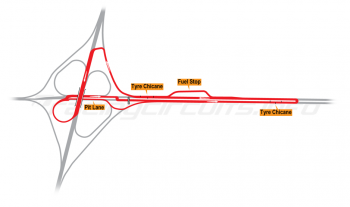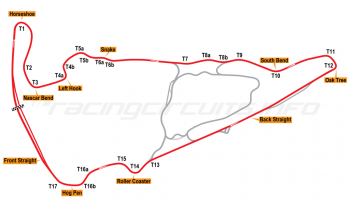Nashville Street Circuit
Circuit Overview
The Music City Grand Prix was first new IndyCar street race announced since Roger Penske took over the helm of the organisation, with its first running in 2021. Running on the streets around the Nissan Stadium and close to the downtown area, the course featured long straights and passed over the Cumberland River twice.
Unusually, more than 1,650 feet of the circuit was located on bridges, utilising the Korean Veteran's Memorial Bridge in both directions.
Redevelopment of the area around the Nissan Stadium prompted a revised course using more of the downtown area to be proposed for 2024, until new management at the event decided to switch the race to Nashville Superspeedway. Whether the popular event returns to the streets in future remains to be seen.
Circuit History
Announced in September 2020, the first Music City Grand Prix was scheduled for August 8, 2021, part of a three day festival event combining racing with good food and live music (the city's trademark).
The track was designed by go-to IndyCar street circuit guru, Tony Cotman, whose NZR Consulting Company has also been responsible for layouts at Baltimore, Edmonton, Sao Paulo and the aborted Boston IndyCar race, among others. Cotman had actually been considering designs for the Nashville race for a number of years but, with city officials initially reluctant to allow use of the Korean Veteran's Memorial Bridge, felt the resulting designs were too 'Mickey Mouse' to be suitable for racing. Happily, this constraint was removed when the race deal was finally announced.
The start line is located on the Memorial Bridge itself, though the finish is located in front of the Nissan Stadium and the pit area, in order to ensure fans in the grandstands and suites can see the race finish in full.
Turn 1 of the new course is where the action is expected to focus, with an 80 feet wide corner entry being among the widest on the calendar. For that reason there will be a number of grandstands located in the area.
Work to resurface some of the roads which make up the track took place in the lead up to the first race in 2021, along with some alterations to the infrastructure which were required for safety. The section between Turn 1 and 2 was a particular focus as construction vehicles for a new hotel had taken a heavy toll on the existing road surface, while there was also some widening in front of the stadium between Turns 3 and 4.
Further resurfacing was also needed in the Turn 7-10 area, with Cotman confirming ahead of the event that some surface grinding was required to iron out some bumps.
Bumpy track gives drivers a tough time
Nevertheless, when the cars hit the track for first practice, they still found plenty of bumps to contend with, especially on the transitions onto and off the Korean Veteran's Memorial Bridge. Conor Daly, in particular, had a heavy crash at Turn 1 during the opening practice when he found a bump under braking and lost control, while early onboard footage from Colton Herta showed the violent shaking the drivers experienced. “I thought the bridge was going to be bumpy, but I didn’t expect coming off the bridge to be quite that bumpy,” said Herta afterwards.
Elsewhere Pato O'Ward was also finding the bumpy course tricky after hitting the wall at Turn 3. “Man, it’s violent,” O’Ward said after his collision. “Going into Turn 4, the bumps are very violent. I mean, you’re going through there, and the wheel is like getting knocked out of your hands. It’s very unique. It’s unlike any other place we go to, for sure.”
Following practice, race organisers tried to alleviate the worst of the bumps with surface grinding at key parts of the track, although there was a limit to how effective this was likely to be. Jimmie Johnson proved the track was still tough to tame, crashing heavily out of qualifying and having to switch to a backup chassis for the race.
The race itself was full of incident, with nine caution periods resulting in a total of 33 of the event's 80 laps run under caution conditions and two race stoppages. It also saw a spectacular fightback by Marcus Ericsson, who was penalised for hitting Sebastian Bourdais as the cars prepared to restart after the first yellow flag session. His car rode over the back of the Frenchman's, putting Bourdais out and breaking Ericsson's front wing. Somewhat ironically, the penalty and subsequent pit stops ultimately put Ericsson on the best fuel strategy and he went on to win the race, with a true 'burn from the stern' drive!
Stadium redevelopment prompts circuit change
After two successful return races by the IndyCar Series, the momentum of the Music City Grand Prix was such that the series decided to make it the final event of the championship for 2024.
With the change of date came a proposed new course layout, forced by redevelopment around part of the course. A new NFL stadium for the Tennessee Titans is being constructed, using the land where the pits and paddocks were previously located.
The new course was set to continue making use of the Korean Veterans Bridge, but relocated the bulk of the course to the south of the river, centred on the famous Broadway area of the city. The revised route was set to take the cars past the Country Music Hall of Fame, a popular destination for visitors of the city attracting over a million per year.
The section outside the Nissan Stadium was omitted owing to the stadium works, with drivers instead drivers looping back across the bridge to a squared off section between Turns 5 and 7. A major drawback of the proposed layout was the small area for the pit lane, which was squeezed into a stadium parking lot on the outside of Turn 3, double backing on itself. There was no room for the paddock itself, which was relocated to parking lots next to Cumberland Park.
Sponsor takes control, race switches venue
In February 2024 it was announced that Big Machine Label Group Chairman and Founder Scott Borchetta was taking a new leadership role in the operations of the Grand Prix. He undertook an immediate review of every aspect of the organisation and plans for the event, determining that a switch to Nashville Superspeedway was the best way forward. This spelled the end of the plans to run the race on the streets.
Explaining his decision, he said: “With construction set to begin for the new Titans Stadium, the Grand Prix operations team knew they’d be faced with new challenges, knowing that the course used for the first three years would have to change dramatically for 2024’s race.
“With several key locations around the stadium not available as in years past and with the proposed course change to run through the streets of downtown Nashville, we simply don’t have the proper space needed by the race teams nor the proper access for downtown businesses and residences to execute the world-class event that is expected by our amazing fans, IndyCar teams and sponsors.
"With the significant challenges of the proposed new layout and unknowns with the new stadium construction, which has been the centre of operations for the first three years of the Grand Prix, the decision has been made to move the 2024 race to the Nashville Superspeedway."
Whether or not the street returns in future years once the new Tennessee Titans stadium is constructed remains to be seen. In the meantime, it appears the frenetic street racing that characterised the Music City Grand Prix is now a thing of the past.
Jump onboard
Circuit info
This is a historic circuit which is no longer in operation.
- 1 Vantage Way, Nashville, TN, United States, Tennessee
Rate This Circuit
Votes: 2092
Location Information
The Music City Grand Prix was staged on a temporary circuit in downtown Nashville, centred on the Nissan Stadium. The nearest airport is Nashville International, only seven miles from the downtown area where the race is based.
Get your race tickets!
Brought to you with: 
We've teamed up with Motorsports Tickets to bring you the best deals for Formula One, MotoGP, Le Mans and more.









